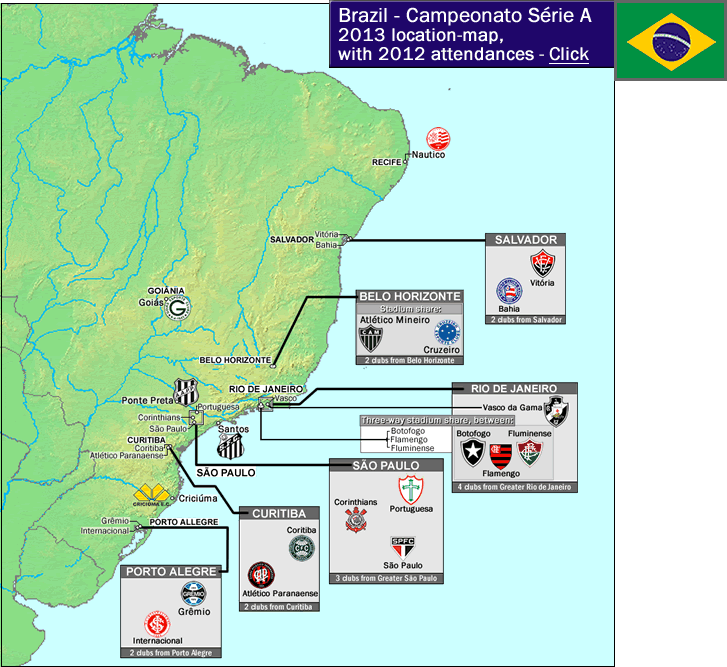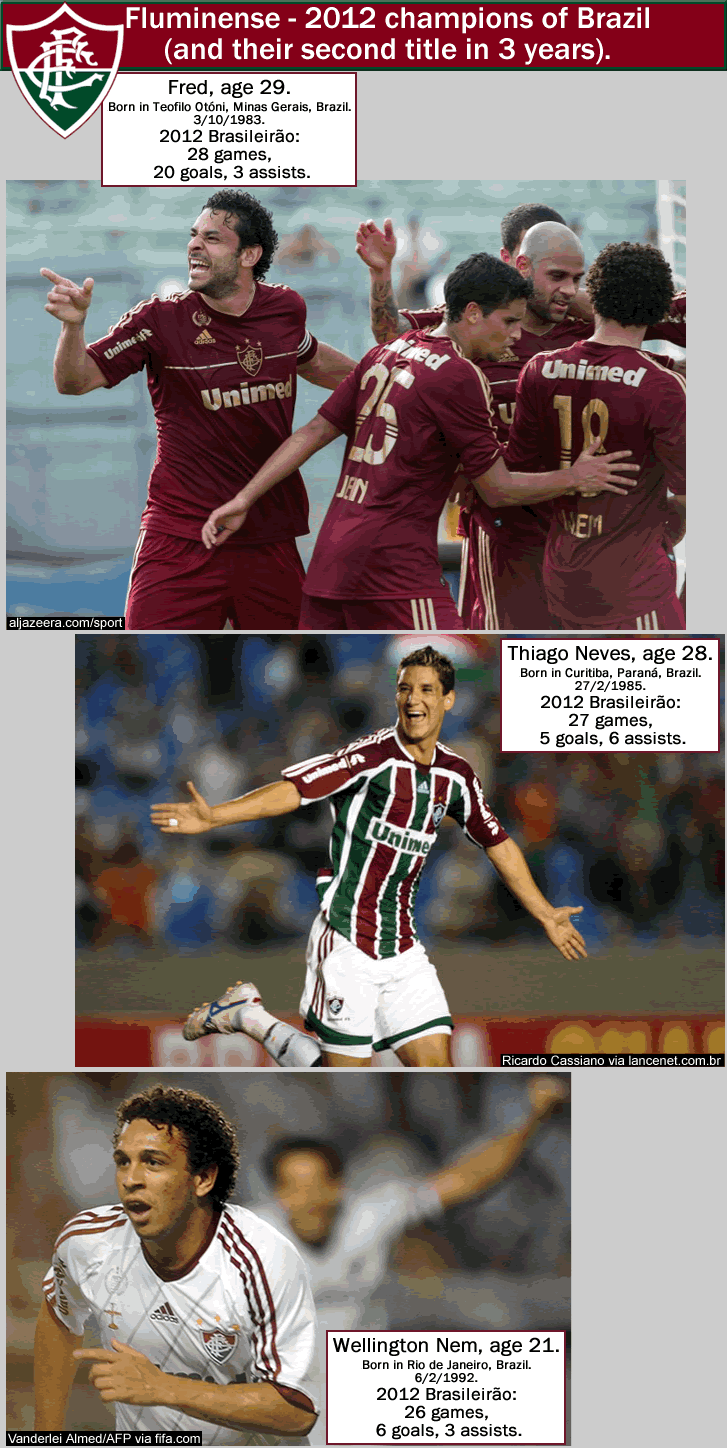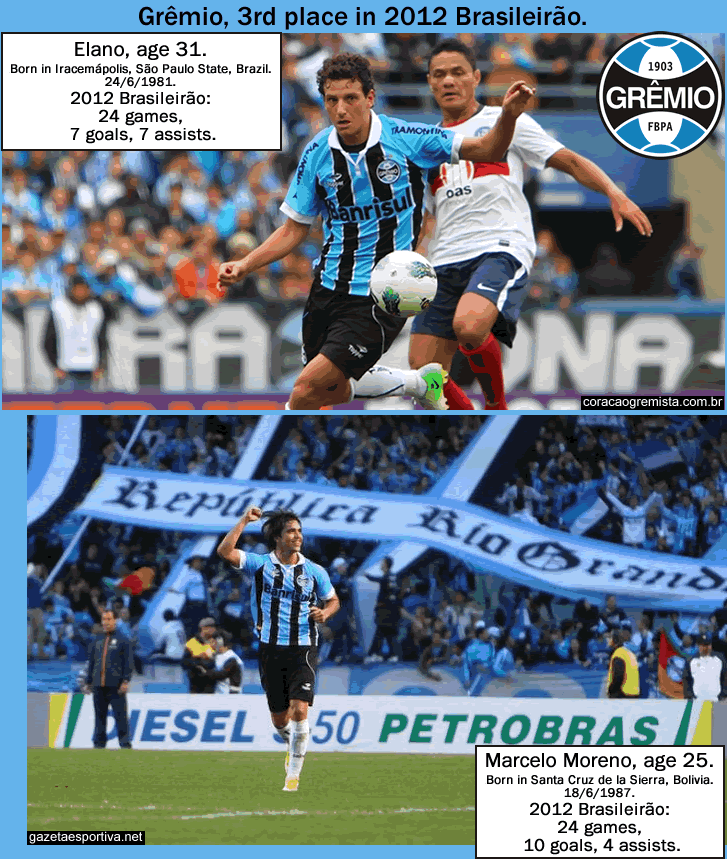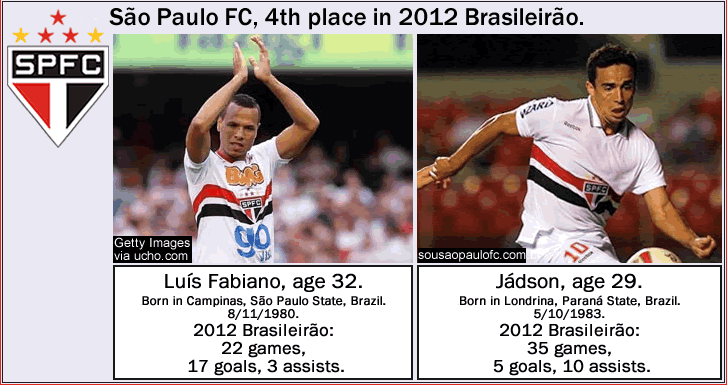
Brazil: 2013 Campeonato Brasileiro Série A location map, with 2012 average attendance
Campeonato Brasileiro Série A (commonly referred to as the Brasileirão) is the top flight of football in Brazil. The 2013 season begins on 25 May.
Brazilian Série A [Brasileirão] – fixtures, results, table (soccerway.com).
‘List of Brazilian football champions‘ (en.wikipedia.org).
…
Further below are illustrations featuring goals and assists leaders from the top 4 teams in 2012 Campeonato Brasileiro Série A. I am showing the top 4 because in Brazil, first place through 4th place qualify for the Copa Libertadores the following year. Also included are some photos of Grêmio’s new stadium in Porto Alegre, which opened in December 2012, and which has a seated capacity of around 60,000. And it is not a municipal stadium – Arena do Grêmio is owned by Grêmio. And unlike the vast majority of first-division (municipal) stadiums in Brazil, it doesn’t have a running track. Another good sign of stadia improvements in Brazil is the nice redevelopment at Estádio Independência, which is the 25,000-capacity municipal stadium that second-place finishers Atlético Mineiro share with another Belo Horizonte, Minais Gerais state-based club, the second division side América MG. Like Grêmio’s new stadium, the essentially brand-new Estádio Independência also dispenses with the superfluous running track and features nice steep-angled stands situated very close to the pitch {see this, ‘Estádio Independência‘ (stadiumguide.com/independencia)}. [Note - you can see a photo of one of the new stands at Estádio Independência further down in this post in the Atlético Mineiro section.]
The soul-less, poor-sight-line-plagued municipal-stadium-with-useless-running-track has been a bane on Brazilian football for decades, and it is, along with the threat of in-stadium violence and the threat of pre- and post-match violence, one of the contributing factors to the poor attendance in Brazilian football. There are several other factors depressing overall first division attendance in Brazil. The rebuilding of stadiums slated to host matches in the 2014 FIFA World Cup in Brazil has disrupted some clubs like Internacional (of Porto Alegre). And a couple big clubs – Fluminense and Flamengo – are currently forced to play elsewhere in Rio de Janeiro (at Engenhão in a 3-way-stadium-share with Botofogo) while their regular venue, Maracaná, is being refurbished for the 2014 World Cup. There are also factors like poor start times such as at 10 pm to accommodate televised broadcasts. There is also a certain amount of resentment among Brazilians in seeing virtually all their best players that are in the prime of their careers opting to play their pro football in Europe. The fact of the matter is that many millions of Brazilians follow first division fútbol in Brazil. They just don’t go to the matches, and only watch the Brasileirão on television.
Brazil is a nation with such a rich history of sporting accomplishment – Brazil has won 5 FIFA World Cup titles, the most of any nation. Brazil is a nation with a gigantic population (193 million {2012 estimate}). And Brazil is a nation with many large cities {see the following link, which shows 13 Brazilian cities with more than 2 million people in their metro-areas, and 22 cities with more than 1 million people in their metro-areas, ‘List of largest cities in BrazilLargest metropolitan areas‘ {en.wikipedia.org).
Yet despite all that, Brazil is a nation whose biggest football league is so poorly supported that over half the clubs – 14 clubs in fact last season – can’t even draw above 13,000 per game. And the per-game cumulative league average has plummeted in the last few seasons. The Campeonato Brasileiro Série A averaged 12,983 per game in 2012. That is really low.
By way of comparison, see the following chart [data of which originally appeared in the May, 2013 issue of World Soccer (page 25)], which shows that throughout the entire world, Brazil had only the 13th-highest league average attendance in 2011-12 {http://billsportsmaps.com/?p=22541
[note: the 21-per-game disparity in Brazil's league average is due to the fact that, in this post here, attendance is measured by paid tickets - numbers via http://globoesporte.globo.com/futebol/noticia/2012/12/corinthians-tem-melhor-media-de-publico-de-todas-divisoes-em-2012.html; while in the post I just linked to above, attendances were measured by total spectators (that is, spectators who paid for tickets plus media and spectators who got in for free}.
Currently, there are a number of national leagues that one would not consider to be able to out-draw the Brazilian top flight, but are doing just that. Specifically, the first division leagues in Mexico (Liga MX), in China (the Chinese Super League), in the United States/Canada (MLS), and in Japan (J.League) all outdraw the Brazilian top flight these days.
The following article mentions the attendance decline in Brazil. From independent.co.uk, from 25 October 2012, by James Young, 'Prices soaring and attendances plummeting: The great soap opera of Brazilian football'.
...
-
Top 4 finishers in the 2012 Brasilerão (Fluminese {champions}, Atlético Mineiro, Grêmio, São Paulo FC).
- From Rio de Janeiro -
Fluminense, 2012 champions of Brazil.
Below, top 3 scoring threats for Fluminense in 2012, Fred, Thiago Neves, and Wellington Nem - all of whom return to Fluminense for 2013.
The Minais Gerais state-born Frederico Chaves Guedes, aka Fred, has previously played for two Belo Horizonte, Minas Gerais-based clubs - for second-division-club América MG (from 2002-04) and then for one of Belo Horizonte's big-two clubs, Cruzeiro (from 2004-05, where he scored 24 goals in 43 league appearances), and then for 4 seasons in France with Lyon (2005–09), where in 2006, '07, and '08 he contributed to the last 3 of Lyon's 7-straight titles. Fred scored 34 goals in 88 league appearances for Lyon. Fred requested to leave the club in December 2008. In early 2009, after refusing to return from Brazil, Fred was released from Lyon, and he signed a 5-year contract with Rio de Janeiro's Fluminense. Fred scored 12 goals in 20 league appearances in 2009 for Flu; then in an injury-hampered 2010, he made just 14 league appearances with 5 goals as Fluminense won the 2010 Brasileiro title led by midfield wizard Dario Conca (who now, strangely, plays in China). In 2011 Fred was healthy again and netted a stupefying 20 goals in 22 league appearances. In 2012, Fred was almost as prolific - he scored 20 goals in 28 league appearances as Fluminense cruised to their second title in 3 years. Fluminense began pulling away from the pack near the seasons' close late in October 2012, but then Flu stumbled to the finish line, losing 2 of their last 3 matches, ending up finishing 5 points ahead of second-place-finishers Atlético Mineiro.
The Curitiba, Paraná state-born attacking midfielder Thiago Neves has previously played in Brazil (getting his start with hometown/second-division-club Paraná, from 2005-07), then in Japan (with Vegalta Sendai in 2006), then briefly in Germany (6 games for Hamburger SV in 2008-09), and then in Saudi Arabia (with Riyadh's Al-Hilal FC for 2 seasons from 2009-11). It was with Al-Hilal that Neves returned home to Brazil via 2 different loan spells, first with Fluminense in 2009, then 2 years later in 2011 with Flamengo, where he scored a respectable 12 goals in 33 league appearances. In January 2012, for 16 million Brazilian reals ($7.9 million US dollars), Thiago Neves was transferred from Al-Hilal to Fluminense. Last season, with 5 goals and 6 assists in 29 league appearances for Flu, Neves made a solid contribution to Fluminense's 2012 Brasileirão title.
Wellington Nem (born Wellington Silva Sanches Aguiar in Rio de Janeiro) is a 21-year-old hometown product who plays as an attacking midfielder/winger for Fluminense. In 2011 he was loaned out to the Florianópolis, Santa Catarina state-based yo-yo club Figueirense, scoring 9 goals in 28 league games as a 19-year-old. Last season his 6 goals and 3 assists in 26 league games for Fluminense contributed to the club's successful title run. It remains to be seen whether Flu will seek to sell off Wellington Nem (like they did with Dario Conca 2 years ago).
On 8 May 2013, Fluminense clinched advancement to the final 8 in the 2013 Copa Libertadores by beating Ecuador's Emelec 4-1 aggregate. Fluminense are now well-positioned to win their first Copa Libertadores title this summer. 5 years ago, Fluminense made it to the 2008 Copa Libertadores Finals, but were upended in a shock result by LDU Quito. Now they aim to go all the way.
On 22 May, in Rio de Janeiro, Fluminense will face Olimpia of Paraguay in the first leg of the 2013 Copa Libertadores Quarterfinals.

Photo credits above -
aljazeera.com/sport.
Ricardo Cassiano via lancenet.com.br.
Vanderlei Almed/AFP via fifa.com.
...
From Belo Horizonte, Minas Gerais state - Atlético Mineiro (aka Atlético MG), 2nd place in the 2012 Brasileirão.
Below, top 3 scoring threats for Atlético Mineiro in 2012, Ronaldinho, Bernard, and Jô - all of whom return for 2013.
Ronaldinho, the 33-year old Porto Alegre-born free kick specialist and playmaker, got his pro start with Grêmio from 1998-2001, before a 5 million Euros transfer to Paris Saint-Germain, where he played from 2001 to 2003. In 2003, a 32.5 million Euros transfer saw him move to FC Barcelona, where he basically became one of the planet’s best footballers circa 2003 to 2006 (winning the Ballon d’Or in 2003-04 and in 2005-06). Ronaldinho scored 70 goals in 145 league matches for the Catalan giants, but by 2008, a hard partying lifestyle and the onset of an on-field complacency saw him fall out of favor with the Barça management, and he was sent to Milan, where he remained from 2008 to 2011. Then Ronaldinho (wisely) decided to return home to Brazil as a 31-year-old, and signed with Flamengo, playing 2 seasons for the Rio de Jameiro giants in 2011 and '12, scoring 15 goals in 33 league matches. But in May, 2012, Ronaldinho sued Flamengo claiming lack of payment for four months and cancelled his contract with the club. Less than a week later he made a surprise signing with Belo Horizonte-based Atlético Mineiro (rather than signing with a Rio de Janeiro-based club or São Paulo-based club). Ronaldinho energized the Atlético MG squad, and led the club to a very credible second-place finish in 2012.
Atlético Mineiro led the league in scoring in the 2012 Brasileirão with 64 goals. Ronaldinho scored 9 and made 11 assists in 32 league appearances. Besides Ronaldinho, there were two other players who had stand-out offensive numbers for Atlético Mineiro in 2012. One was another ex-European star, Jô (who made his name in Russia with CSKA Moscow from 2004-06 [with 30 goals in league 52 games there] before stints at Everton and Manchester City, among other places). Jo scored 10 goals and made 4 assists. Another was young hometown product Bernard, a 20-year-old playmaker with huge potential, who scored 11 goals and made 11 assists in 32 league appearances.
In early 2013, Atlético MG were bolstered by the addition of striker Diego Tardelli (who is back for his second spell with the club; Diego Tardelli’s Wikipedia page here). Now in early May 2013, the squad has clinched advancement to the final 8 in the 2013 Copa Libertadores. So Atlético Mineiro, at the #1 seed in the tournament now, have a solid shot at winning their first Copa Libertadores title. The main thing that Atlético Mineiro have going for them is that the squad, centered around Ronaldinho and full of players who can find the net with ease, is playing in a relaxed manner, and seem to be enjoying themselves immensely. They have scored 22 goals in 8 games in the tournament so far, with Jô scoring 6 (tournament leader), Diego Tardelli scoring 5, and Ronaldinho scoring 4 goals.
Here is a recent article on the subject by Jonathan Wilson from 16 April 2013, from Guardian.co.uk, ‘The Copa Libertadores and differing stories for Ronaldinho and Riquelme – As Juan Román Riquelme frowns his way across the continent, the contrast with Ronaldinho’s grin has never been greater‘ (guardian.co.uk/football).
On 22 May, in Tijuana, Mexico, Atlético Mineiro will face Mexican upstarts Tijuana (aka Xolos) in the first leg of the 2013 Copa Libertadores Quarterfinals.

Photo credits above -
Bruno Cantini/Flickr do Atlético-MG via esporte.uol.com.br .
Bruno Cantini/Flickr do Atlético-MG via goal.com.
Unattributed at pes2014ps2.blogspot.com
Screenshot of http://espnfc.com/video/espnfc/video?id=1440687&cc=5901.
…
From Porto Alegre, Rio Grane do Sul state – Grêmio, 3rd place in the 2012 Brasileirão.
Below, top 2 scoring threats for Grêmio in 2012, Elano Blumer and Marcelo Martins Moreno.
Elano has previously played for Santos (twice), Shakhtar Donetsk, Manchester City, and Galatasaray. The 31-year-old Elano returns in 2013 for his second season at Grêmio (after a two-year stint at Santos which included his contributing to Santos’ 2011 Copa Libertadores title).
Marcelo Moreno, after signing a 5-year contract with Grêmio in 2012, starts 2013 on loan at Flamengo. A 25-year-old Bolivian international with 11 goals in 36 games for Boloivia, Marcelo Martins Moreno has previously played for Vitória, Cruzeiro, Shakhtar Donetsk, Werder Bremen (loan), and Wigan Athletic (loan).
On 16 May, in Bogotá, Colombia, Grêmio were eliminated from the 2013 Copa Libertadores Round of 16 when they lost 0-1 to Santa Fe (2-2 aggregate/with away goals rule) to Santa Fe.

Photo credits above -
coracaogremista.com.br.
gazetaesportiva.net.
Arena do Grêmio, the new home of Grêmio. In Porto Alegre, Rio Grand do Sul.

Photo and Image credits above -
gremio.net.
Exterior photo (night-time) of Arena do Grêmio from skyscrapercity.com uploaded by batedordemartelo.
Aerial photo of Arena do Grêmio from wp.clicrbs.com.br .
Interior photo of Arena do Grêmio from arenadogremio.blogspot.com.
…
Sào Paulo FC, 4th place in the 2012 Brasileirão.
Below, top 2 scoring threats for São Paulo in 2012, Luis Fabiano and Jádson, both of whom return for 2013.
Luís Fabiano got his start in 1999 at tiny, current first-division/Greater São Paulo-based-club Ponte Preta. Luís Fabiano followed that with a disappointing year-and-a-half at Rennes in Brittany, France. Luís Fabiano then made his mark at his next stint, 4 seasons with São Paulo, in 2001-04. There, he scored an astounding 61 goals in 87 league matches for the São Paulo. Then it was on to another frustrating spell at a European club, this time with Porto in northern Portugal in 2004-05. But Fabiano finally found a place on the European continent where his speed and scoring ability could mesh with the set-up already there – and that of course was at Sevilla in the south of Spain, where he spent 6 seasons, scoring 72 goals in 149 league matches. Fabiano headed in the winning goal in the 2006 UEFA Cup Final versus Middlesbrough. The next season, 2006-07, Luís Fabiano scored 24 goals for Sevilla, and was finally recalled to the Brazilian national team squad after 3 years of being left off the ‘seleção’. Sevilla won the UEFA Cup again that season (in 2007 over Espanyol). After 4 more seasons at Sevilla, in March 2011, Luís Fabiano decided to return to Brazil and to play again for São Paulo FC. São Paulo paid €7.6 million for Fabiano, who signed a four-year deal.
The 29-year-old Jádson had previously played for Atlético Paranaense, and for Shakhtar Donetsk in eastern Ukraine. With Shakhtar, Jádson scored the winning goal in extra time in a 2–1 victory to win the 2009 UEFA Cup Final versus Werder Bremen in Istanbul. Jádson was named Man of the match. The attacking midfielder scored 41 goals in 173 league matches with Shakhtar Donetsk. After seven years in Ukraine, Jádson returned to his native Brazil in 2012, helping São Paulo snatch the last available Copa Libertadores spot with their 4th place finish in the 2012 Brasileiro.
In early May, 2013, São Paulo FC were eliminated by Atlético Mineiro in the 2013 Copa Libertadores Round of 16.

Photo and Image credits above -
ucho.info.
sousaopaulofc.com.br.
___
Thanks to globoesporte.globo.com/ – attendance figures from http://globoesporte.globo.com/futebol/noticia/2012/12/corinthians-tem-melhor-media-de-publico-de-todas-divisoes-em-2012.html.
Thanks to the contributors to the pages at en.wikipedia.org and pt.wikipedia.org, ‘Campeonato Brasileiro Série A‘.
Thanks to ESPN for stats, such as espnfc.com/team/squad/_/id/3445/season/2012/seasonType/21/league/bra.1/fluminense-fc?cc=5901.
